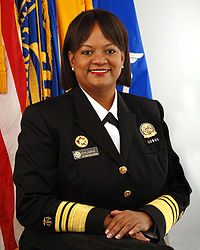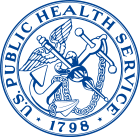- Surgeon General of the United States
-
Surgeon General of the United States
Incumbent:
VADM Regina Benjamin
since: 11 January 2010First John M. Woodworth Formation 29 March 1871 Website Official Website
The Surgeon General of the United States is the operational head of the Public Health Service Commissioned Corps (PHSCC) and thus the leading spokesperson on matters of public health in the federal government. The Surgeon General's office and staff are known as the Office of the Surgeon General (OSG).
Contents
Selection and current office-holder
The Surgeon General is nominated by the U.S. President and confirmed via majority vote by the Senate. The Surgeon General serves a four-year term of office and, depending on whether the current Assistant Secretary for Health is a PHSCC commissioned officer or not, is the senior or second-highest ranking uniformed officer of the PHSCC, holding the grade of a three-star vice admiral while in office.[1] The current Surgeon General is Regina Benjamin, who was confirmed by the U.S. Senate on October 29, 2009. She was unofficially sworn in to begin work on November 3, 2009,[2] and was officially sworn in January 11, 2010.[3]
Responsibilities
The Surgeon General reports to the Assistant Secretary for Health (ASH), who may be a four-star admiral in the United States Public Health Service Commissioned Corps (PHSCC), and who serves as the principal advisor to the Secretary of Health and Human Services on public health and scientific issues. The Surgeon General is the overall head of the Public Health Service Commissioned Corps, a 6,000-member Commissioned Corps of the USPHS, a cadre of health professionals who are on call 24 hours a day, and can be dispatched by the Secretary of HHS or the Assistant Secretary for Health in the event of a public health emergency.
The Surgeon General is also the ultimate award authority for several public health awards and decorations, the highest of which that can be directly awarded is the Surgeon General's Medallion (the highest award bestowed by board action is the Distinguished Service Medal). The Surgeon General also has many informal duties, such as educating the American public about health issues and advocating healthy lifestyle choices.
The office also periodically issues health warnings. Perhaps the best known example of this is the Surgeon General's Warning labels that can be found on all packages of American cigarettes. A similar health warning appears on alcoholic beverages.
History
In 1798, Congress established the Marine Hospital Service—predecessor to today’s United States Public Health Service—to provide health care to sick and injured merchant seamen. In 1870, the Marine Hospital Service was reorganized as a national hospital system with centralized administration under a medical officer, the Supervising Surgeon, who was later given the title of Surgeon General.[4]
The U.S. Public Health Service was under the direction of the Office of the Surgeon General and was an independent government agency until 1953 at which point it was integrated into the United States Department of Health, Education, and Welfare, and later into the United States Department of Health and Human Services. Although the U.S. Public Health Service and the Surgeon General were at various times under the umbrella of the Department of the Treasury or the Federal Security Agency, the agency operated with a substantial amount of independence.
Some Surgeons General have been noted for being outspoken and advocating controversial proposals on how to reform the U.S. health system.[citation needed] The office is not a particularly powerful one, and has little direct impact on policy-making, but Surgeons General are often vocal advocates of unconventional or unpopular health policies.
- In 1964, Dr. Luther Terry, M.D., published a landmark report saying that smoking may be hazardous to health,[5] sparking nationwide anti-smoking efforts. Terry and his committee defined cigarette smoking of nicotine as not an addiction (the committee was made of largely physicians who themselves smoked). This error wasn't corrected for 24 years.[6]
- In 1986, Vice Admiral C. Everett Koop's report on AIDS called for some form of AIDS education in the early grades of elementary school and gave full support for using condoms for disease prevention.[7]
- In 1994, Vice Admiral Joycelyn Elders had spoken at a United Nations conference on AIDS. She was asked whether it would be appropriate to promote masturbation as a means of preventing young people from engaging in riskier forms of sexual activity, and she replied, "I think that it is part of human sexuality, and perhaps it should be taught."[8]
The U.S. Army, Navy, and Air Force also have officers overseeing medical matters in their respective services who hold the title Surgeon General.
The insignia of the Surgeon General, and the USPHS, use the caduceus. See Caduceus as a symbol of medicine.
Service rank
The Surgeon General is a commissioned officer in the Public Health Service Commissioned Corps, one of the seven uniformed services of the United States, and by law holds the rank of vice admiral.[1] Officers of the Public Health Service Commissioned Corps are classified as non-combatants, but can be subjected to the Uniform Code of Military Justice (UCMJ) and the Geneva Conventions when designated by the Commander-in-Chief as a military force or if they are detailed or assigned to work with the armed forces. Officer members of these services wear uniforms that are similar to those worn by the U.S. Navy, except that the commissioning devices, buttons, and insignia are unique. Officers in Public Health Service wear unique devices which are similar to U.S. Navy Staff Corps Officers (e.g., Navy Medical Service Corps, Supply Corps, etc.).
The only Surgeon General to hold the rank of a four-star admiral was David Satcher. This was because he served simultaneously in the positions of Surgeon General (three-star) and Assistant Secretary for Health (which is a four-star office).[9]
Surgeons General of the United States
# Name Photo Term of Office Appointed by Start Of Term End Of Term 1 John M. Woodworth 
29 March 1871 14 March 1879 Ulysses S. Grant 2 RADM John B. Hamilton 
3 April 1879 1 June 1891 Rutherford B. Hayes 3 RADM Walter Wyman 
1 June 1891 21 November 1911 Benjamin Harrison 4 RADM Rupert Blue 
13 January 1912 3 March 1920 William Taft 5 RADM Hugh S. Cumming 
3 March 1920 31 January 1936 Woodrow Wilson 6 RADM Thomas Parran, Jr. 
6 April 1936 6 April 1948 Franklin D. Roosevelt 7 RADM Leonard A. Scheele 
6 April 1948 8 August 1956 Harry S. Truman 8 RADM Leroy Edgar Burney 
1 August 1956 29 January 1961 Dwight Eisenhower 9 RADM Luther Terry 
2 March 1961 1 October 1965 John F. Kennedy 10 VADM William H. Stewart 
1 October 1965 1 August 1969 Lyndon Johnson 11 RADM Jesse Leonard Steinfeld 
18 December 1969 30 June 1973 Richard Nixon (acting) RADM Paul Ehrlich, Jr. 1 July 1973 13 July 1977 12 VADM Julius B. Richmond 
13 July 1977 14 May 1981 Jimmy Carter (acting) Edward Brandt, Jr. 14 May 1981 21 January 1982 Ronald Reagan 13 VADM C. Everett Koop 
21 January 1982 1 October 1989 (acting) ADM James O. Mason 
1 October 1989 9 March 1990 George H. W. Bush 14 VADM Antonia C. Novello 
9 March 1990 30 June 1993 (acting) RADM Robert A. Whitney 
1 July 1993 8 September 1993 Bill Clinton 15 VADM Joycelyn Elders 
8 September 1993 31 December 1994 (acting) RADM Audrey F. Manley 
1 January 1995 1 July 1997 16 ADM[9] / VADM David Satcher 
13 February 1998 12 February 2002 (acting) RADM Kenneth P. Moritsugu 
13 February 2002 4 August 2002 George W. Bush 17 VADM Richard Carmona 
5 August 2002 31 July 2006 (acting) RADM Kenneth P. Moritsugu 
1 August 2006 30 September 2007 RADM Steven K. Galson 
1 October 2007 1 October 2009 RADM Donald L. Weaver 
1 October 2009 3 November 2009 Barack Obama 18 VADM Regina Benjamin[10] 
3 November 2009[2] Incumbent References
- ^ a b Public Health, Commissioned Corps Uniforms and Ranks.
- ^ a b Stobbe, Mike (2009-12-03). "Surgeon general: More minority doctors needed". WTOP. http://www.wtop.com/?nid=106&sid=1829595. Retrieved 2009-12-05.
- ^ http://blog.al.com/live/2010/01/dr_regina_benjamin_will_be_swo.html
- ^ HHS - Office of the Surgeon General - About the Office
- ^ Julie M. Fenster "Hazardous to Your Health" American Heritage, Oct. 2006.
- ^ Joel Spitzer. The Surgeon General says .... WhyQuit.com. http://whyquit.com/videos/addiction2_bb64Kbps.mp3. Retrieved May 22, 2010.
- ^ Winn, Mari (1988-10-09). "The Legacy of Dr. Koop". The New York Times. http://query.nytimes.com/gst/fullpage.html?res=940DE3DE1739F93AA35753C1A96E948260.
- ^ Leon Dash, "Joycelyn Elders: From Sharecropper's Daughter to Surgeon General of the United States of America", Washington Monthly, January–February 1997
- ^ a b "Office of the Surgeon General, David Satcher (1998-2002)". U.S. Department of Health and Human Services. 4 January 2007. http://www.surgeongeneral.gov/about/previous/biosatcher.htm. Retrieved 22 January 2009.
- ^ "Obama picks Regina Benjamin as surgeon general". Reuters. http://www.reuters.com/article/healthNews/idUSTRE56C3HI20090713.
External links
Categories:- Surgeons General of the United States
- United States Public Health Service
- Uniformed services of the United States
- United States Department of Health and Human Services officials
Wikimedia Foundation. 2010.






